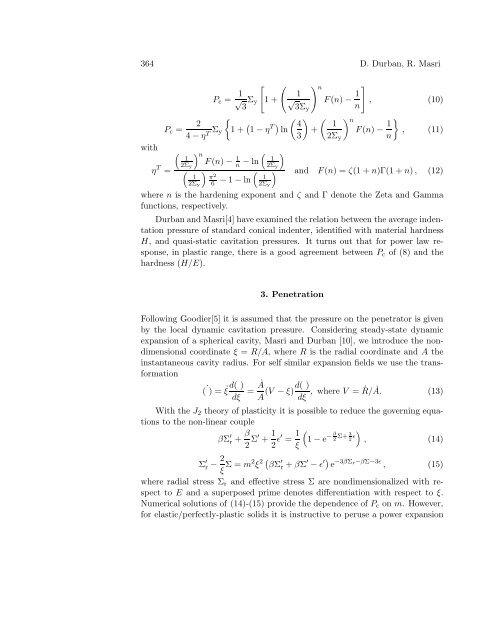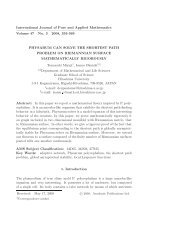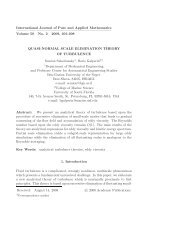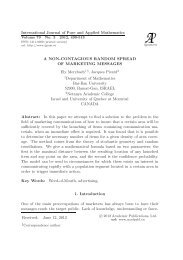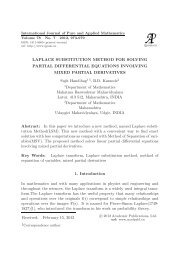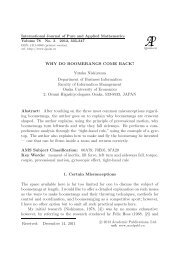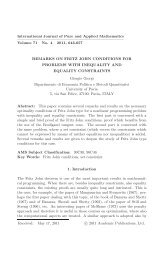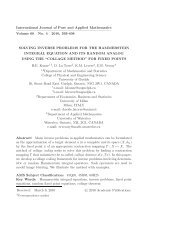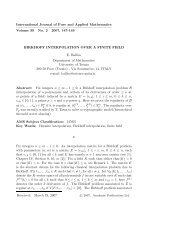CAVITATION, INDENTATION AND PENETRATION
CAVITATION, INDENTATION AND PENETRATION
CAVITATION, INDENTATION AND PENETRATION
Create successful ePaper yourself
Turn your PDF publications into a flip-book with our unique Google optimized e-Paper software.
364 D. Durban, R. Masri<br />
with<br />
η T =<br />
Pc =<br />
Pc = 1<br />
<br />
√ Σy 1 +<br />
3<br />
<br />
2<br />
Σy 1 +<br />
4 − ηT 1 − η T ln<br />
n 1<br />
2Σy<br />
<br />
1 π2 2Σy 6<br />
F(n) − 1<br />
n<br />
− 1 − ln<br />
<br />
1 − ln<br />
1<br />
2Σy<br />
2Σy<br />
<br />
n F(n) − 1<br />
<br />
,<br />
n<br />
(10)<br />
n 4 1<br />
+ F(n) −<br />
3 2Σy<br />
1<br />
<br />
,<br />
n<br />
(11)<br />
1<br />
√ 3Σy<br />
and F(n) = ζ(1 + n)Γ(1 + n), (12)<br />
where n is the hardening exponent and ζ and Γ denote the Zeta and Gamma<br />
functions, respectively.<br />
Durban and Masri[4] have examined the relation between the average indentation<br />
pressure of standard conical indenter, identified with material hardness<br />
H, and quasi-static cavitation pressures. It turns out that for power law response,<br />
in plastic range, there is a good agreement between Pc of (8) and the<br />
hardness (H/E).<br />
3. Penetration<br />
Following Goodier[5] it is assumed that the pressure on the penetrator is given<br />
by the local dynamic cavitation pressure. Considering steady-state dynamic<br />
expansion of a spherical cavity, Masri and Durban [10], we introduce the nondimensional<br />
coordinate ξ = R/A, where R is the radial coordinate and A the<br />
instantaneous cavity radius. For self similar expansion fields we use the transformation<br />
( ˙)<br />
= ˙ d( )<br />
ξ<br />
dξ = ˙ A )<br />
(V − ξ)d(<br />
A dξ , where V = ˙ R/ ˙ A. (13)<br />
With the J2 theory of plasticity it is possible to reduce the governing equations<br />
to the non-linear couple<br />
βΣ ′ β<br />
r +<br />
2 Σ′ + 1<br />
2 ǫ′ = 1<br />
β<br />
−<br />
1 − e 2<br />
ξ<br />
Σ+3 2ǫ , (14)<br />
Σ ′ r − 2<br />
ξ Σ = m2 ξ 2 βΣ ′ r + βΣ ′ − ǫ ′ e −3βΣr−βΣ−3ǫ , (15)<br />
where radial stress Σr and effective stress Σ are nondimensionalized with respect<br />
to E and a superposed prime denotes differentiation with respect to ξ.<br />
Numerical solutions of (14)-(15) provide the dependence of Pc on m. However,<br />
for elastic/perfectly-plastic solids it is instructive to peruse a power expansion


